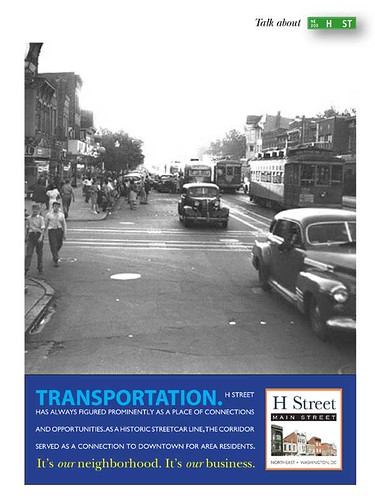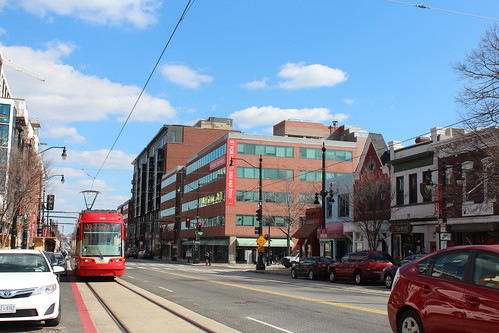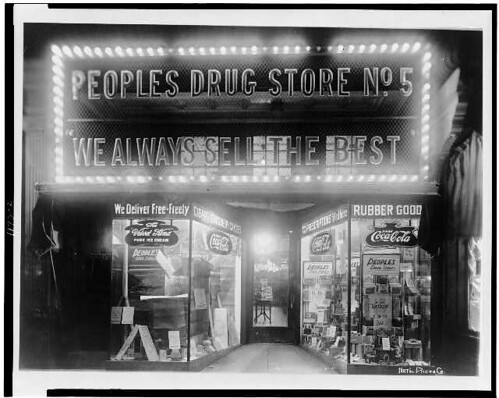The streetcar and the new potential for H Street retail revitalization

An ad for an image campaign for H Street that ran in the Hill Rag and Voice of the Hill circa 2003, created by Kevin Palmer and myself.
The biggest thing I forgot to write about in the Sunday piece was the opportunity to spur retail revitalization on H Street because of the streetcar.
As has been discussed here ad infinitum, the organization of the retail sector has changed significantly, with e-commerce decimating many categories more recently, and consolidation and chaining up marking the sector more generally.
Increasingly, retail outside of major shopping centers has declined in favor of food-oriented eatertainment--restaurants and taverns mostly.
H Street's resurgence is the result of similar actions. Mostly what has come in are restaurants and taverns and business activity occurs at night, when retail stores typically wouldn't be open anyway.
To be successful, retail needs lots of potential customers, and people going out to drink aren't shopping for shirts and furniture.
 Flickr photo by Dan Malouff/BeyondDC.
Flickr photo by Dan Malouff/BeyondDC.But with the launch of the streetcar and the coming of a Whole Foods supermarket on the 600 block of H Street, it will be possible to revive H Street's retail offer, as opposed to the nightlife orientation--bars, taverns, restaurants--it has developed over the past 10 years.
Before suburbanization and riots took their toll, H Street was once one of the city's main commercial districts, not as upscale as downtown, and more friendly to African-American customers.
It was home to Sears and 5 and 10 stores like Kresge, Woolworth, and local firms, and the Morton's regional department store chain, car dealerships, appliance stores, apparel shops, etc.
For the most part, that intensity of retail was lost after the riots, and the corridor repositioned its retail offer towards satisfying the needs of low-income consumers. Hechinger's the old regional equivalent of Home Depot, was successful at beating down Sears, but they never were able to remake their site over as a shopping center comparable in regional dominance to decades before. Many years ago I made the point too that Hechinger Mall repatterned shopping in the corridor towards the car and away from the pedestrian.
 Flickr photo by Matt Johnson.
Flickr photo by Matt Johnson.The streetcar can be the means to restore the pedestrian nature of the corridor.
And in the modern retail era the advantage of grocery stores is that everyone eats and so they experience a great amount of customer traffic--thousands of visits per week. It will be possible to develop some retail, although I can't say how much, in association with the Whole Foods.
I would go for broke and try to attract stores like Primark and Barnes & Noble, repositioning the retail district towards Union Station, which will grow over the decades as the Burnham Place development is constructed over the railyards.
This would recenter the retail segment of the corridor towards to its original "100% intersection" of 8th Street and H Street--which was a major transfer point between different streetcar lines.
Photo source unknown. 90s streetcar going south on 8th Street NE, crossing H Street. The H Street streetcar line was abandoned in February 1949, but the 90s line remained in service for many more years.
It reminds me of an old column on Main Street-related commercial district revitalization by Neal Peirce ("Main Street Niches in Mass Sales World"), who used to write about state and local issues for the Washington Post Writers Syndicate, where he made the point that commercial district revitalization planning was never-ending, it is a continuing process, and that at a minimum, it takes 15-20 years to show significant results.
In keeping with the idea that commercial district revitalization is a long-term and phased process, streetcar service might make realizable the positioning for the H Street corridor I suggested during the revitalization process in December 2002,
Although I will note that DC's high rents--rents on the H Street corridor are more than double the rents of successful "independent" commercial districts in places like Baltimore (Hampden) and Richmond (Carytown), so it will be much more difficult for retail as opposed to restaurants and bars to succeed.
Relatedly, in 2007 the New York Times had a piece on upscale chains moving from Manhattan into regionally-serving traditional commercial districts in Brooklyn and Queens. The article, "Now, Big-Name Retail Chains Will Take the Other Boroughs, Too,"has a great map of Steinway Street in Astoria, Queens, which shows the impact of the influx of chain stores on the nature of retail there. However, cross streets, such as Broadway, are still heome to significant numbers of independent businesses, but increasingly they are food-related.
========
Excerpt from 12/2002 email. It still reads well enough...
 -- I don't think HOK understands the extent of the competition between Hechinger Mall and the H Street commercial district. When Hechinger Mall opened it snatched away from H Street three of the most important generators of pedestrian retail traffic on the corridor--the U.S. Post Office, the Safeway supermarket, and People's Drug Store (now CVS). It also took a key African-American men's clothing store, Cavalier, which at that time was part of a regional chain.
-- I don't think HOK understands the extent of the competition between Hechinger Mall and the H Street commercial district. When Hechinger Mall opened it snatched away from H Street three of the most important generators of pedestrian retail traffic on the corridor--the U.S. Post Office, the Safeway supermarket, and People's Drug Store (now CVS). It also took a key African-American men's clothing store, Cavalier, which at that time was part of a regional chain.CVS's relatively new stand-alone store at Bladensburg Road and H Street eliminated other stores that previously served the neighborhood. CVS's acquisition and consolidation of stores in the neighborhood over the past few years has replaced three stores--600 block, 1100 block (originally Standard Drug), and Hechinger Mall-- with the one store present today.
-- THESE CHANGES negatively affected the quality of the shopping experience in the H Street commercial district by forcing would-be pedestrian shoppers into their cars, to drive outside of their immediate neighborhood, in order to be able to satisfy their most basic shopping needs.
The Sears store was demolished in the early 1990s. Later, the Atlas Flats apartments were built on this site, although the Hechinger Company wanted to build another shopping center here. Across the street is a CVS. At one time the site had a Giant Supermarket, which was one of the company's early stores also.
DEVELOPING DESTINATION RETAIL
I also have a question and some follow up points about your statement at the Revitalization Study presentation last week that the H Street retail market analysis shows the ability to support only 35% of the space we have. The question is where is that 1,000,000 sf? Is it just on H Street or does it include Hechinger Mall and related properties? If the latter, what is the breakdown?
-- I agree that focusing strictly on "neighborhood serving retail" would make it unlikely that we could successfully bring retail to all the spaces on the corridor. However, historically the retail district did not serve just the immediate neighborhood; it was one of the only major shopping districts in the region, probably until the late 1940s. At some point, it became a commercial district particularly hospitable to African-Americans as well.
-- Part of H Street's success was that it had "mall hours" long before there were malls. No later than the 1920s, many H Street stores (including the Sears store on Bladensburg Road, which published its address as "15th and H Streets") were open until 9 pm Wed-Sat. This was particularly important to working people since downtown stores closed at 6 pm. Sears also advertised that its location was convenient to downtown offices, but without the traffic congestion that typified downtown.

One of the earliest People's Drug Stores was located at 802 H Street NE. The chain grew to over 800 stores before it was acquired by CVS.
-- My concern is how can we successfully revive as much of the retail district as is possible? The other 65% of the retail space continues to exist, much of it in significant 19th and 20th century historic buildings. What are we going do with it? I certainly wouldn't suggest demolishing it. I also wouldn't suggest encouraging the use of first floor spaces as offices.
-- I think the way to use the "extra" 65% is to promote destination retail options that attract shoppers from a much greater area than the immediate neighborhood. Such destinations strengthen the overall mix and bring people in who may patronize other stores and services while they are shopping in the neighborhood.
-- Destination stores, as single entities or as part of themed "clusters," could include music instrument stores with classes (like "The Guitar Shop" at 18th and Connecticut), the Washington Uniform Store (now at 11th and I Street NW and likely at some point to move), or stores that can help support certain categories of business.
For example, there is a franchised chain of stores that sells just batteries, but batteries of every type imaginable. A store like that in the vicinity of Park's Hardware and Sonny's Plumbing would generate sales for those stores as well (see story/1 below). Similarly, stores with an Afro-centric theme (galleries, bookstores, etc.) could be another focus. ...
Labels: commercial district revitalization planning, retail planning, streetcars, transit and economic development





2 Comments:
greed can only go so far- look at what went down in 2008. real estate prices and regional local average incomes must be maintained in a rough equation or one of the two is in danger of collapse. Basic repair and maintenance people must be able to access these areas or things fall apart. In San Francisco it has become so expensive for ordinary people to live that many wealthy actually go without repairs or basic things for their properties now. A leveling off and correction must happen.
Interesting point. A new version of "house rich, cash poor."
When I lived in a subdivision in suburban Detroit in the early 1970s, I delivered the Detroit Free Press and so I went house to house to collect.
I remember being shocked how one house had no furniture in the dining room... they didn't use the room evidently, and in terms of being "house rich" and "cash poor" it wasn't something they needed to invest in at the time.
Post a Comment
<< Home